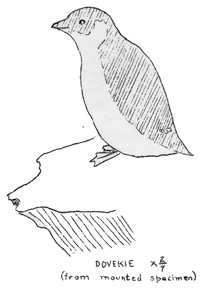

|
|
NATURE NOTES FROM ACADIA

Although seen infrequently, the Dovekie or "Little Auk" can hardly be regarded as a rare winter bird in the region of the waters surrounding Acadia National Park. As with so many other species of feathered migrants which come to us from the north, the numbers of Dovekies tend to fluctuate. The sight of one of these diminutive black and white sea birds tossed about on the frigid winter seas where it is so very much at home is always a memorable experience. These "Ice Birds," as they are known locally, arrive here in November and remain through the winter. Occasionally storms will blow them ashore where, since they apparently are unable to rise from a hard surface, the birds wander helplessly about - a pathetic wandering which often ends in death. A heavy surf may also bring about this unfortunate transportation to the land. A year ago, on November 16, one was found on the doorstep of a house near the Kebo Valley Golf Club; in all probability it had been caught and brought there by a house cat. Nesting in the far north on steep cliffs close to the sea they, like our Black Guillemot or "Sea Pigeon," take wing after leaping out into space. On December 3, 1934, a dead Dovekie was found approximately 100 yards from the sea in a dense stand of spruce at Great Head. The bird, which apparently met death but recently, was taken to Mrs. J. Franklin Anthony, bird-lover, who kindly presented me with the specimen. I found it to be in excellent plumage, the top of the head, the back, wings, and tail a rich satiny black as contrasted to its clean white underparts. Taxidermists at the Fred C. N. Parke establishment in Bangor informed me that they had received two of these Little Auks which were killed at about the same time. Previous to this experience with the bird, Mrs. Anthony has encountered it at Great Head on two former occasions, and she has very kindly favored me by writing the following accounts which, of necessity, I have abbreviated: On New Year's Day, 1932, a Dovekie was reported to have come out of the water at the Sand Beach, Great Head, and accept food from the hands of a party of people who were picnicing there at the time. According to the report the bird was so unafraid that a telephone message brought a man interested in bird-photography to the scene, but by the time of his arrival the bird had disappeared. Six days later, at no great distance from the Sand Beach, a smaller group of men engaged in dismantling an old building, the remains of which were being fed to a huge bonfire nearby, picked up a Dovekie which had been wandering about in the immediate vicinity. The bird, brought to Mrs. Anthony by her son, accepted food from the hand but did not appear to be very hungry. It being the first Dovekie she had ever seen to such good advantage, Mr. Anthnny admired its attractive plumage and was thrilled by its ~onfiding manner. Being an enthusiastic and inveterate bird-bander she placed a little aluminum bracelet around one of its legs, photographed the bird in the band, and then had it released in the ocean waters at Sand Beach. Unable to make progress against the heavy surf which prevailed, the breakers returning it to the beach time and again, the Dovekie was taken to deeper water in the lee of a large rock where it immediately dived for the bottom, came up, and dived again - at home in its element. A few days later, in a letter from Dr. John B. May, at that time Director of the Division of Ornithology, Massachusetts Department of Agriclture, Mrs. Anthony was informed that the bird in question was but the third one of its kind ever to be banded in the Northeastern District. Mrs. Anthnny's second experience with this bird took place on November 20, 1932, at the very same place. A stray cat, upon being discovered with a bird in its jaws, dropped its prey and fled. The bird, which proved tn be a Dovekie, was brought to the bird-lady at Great Head. It appeared to be unhurt, but as night was falling and as a strong wind and heavy surf prevailed, Mrs. Anthony thought it best to wait until morning before releasing it in the sea. That night, acting upon an experience which Dr. May had had with one of these birds, an account of which he gave in his letter which has just been mentioned, Mrs. Anthony released the Dovekie in the water in a bath tub where it became very active, swimming, diving, and walking on the surface of the water. Although endeavoring to fly, the bird was unable to raise itself more than a few inches. No fod was found acceptable to it. Before retiring, the bird's keeper had a rock, about the size of a teakettle, placed in the bath tub. To this the Dovekie soon swam and began preening its feathers. After more antics in the water it settled on the rock for the night and appeared to fall asleep; if so, the bird never awakened. Next morning, upon finding its lifeless body in much the same position as when she left it, Mr s. Anthony expressed keen r eGret for not having taken the Dovekie to the sea on the previous night, but upon skinning it, preparatory to mounting the specimen, she came upon a large tell-tale clot of blood close to the bird's heart - at a place where the teeth of the cat had penetrated its breast. - Arthur Stupka |
| <<< Previous | > Cover < | Next >>> |
nature_notes/acad/vol3-6e.htm
09-Jan-2006